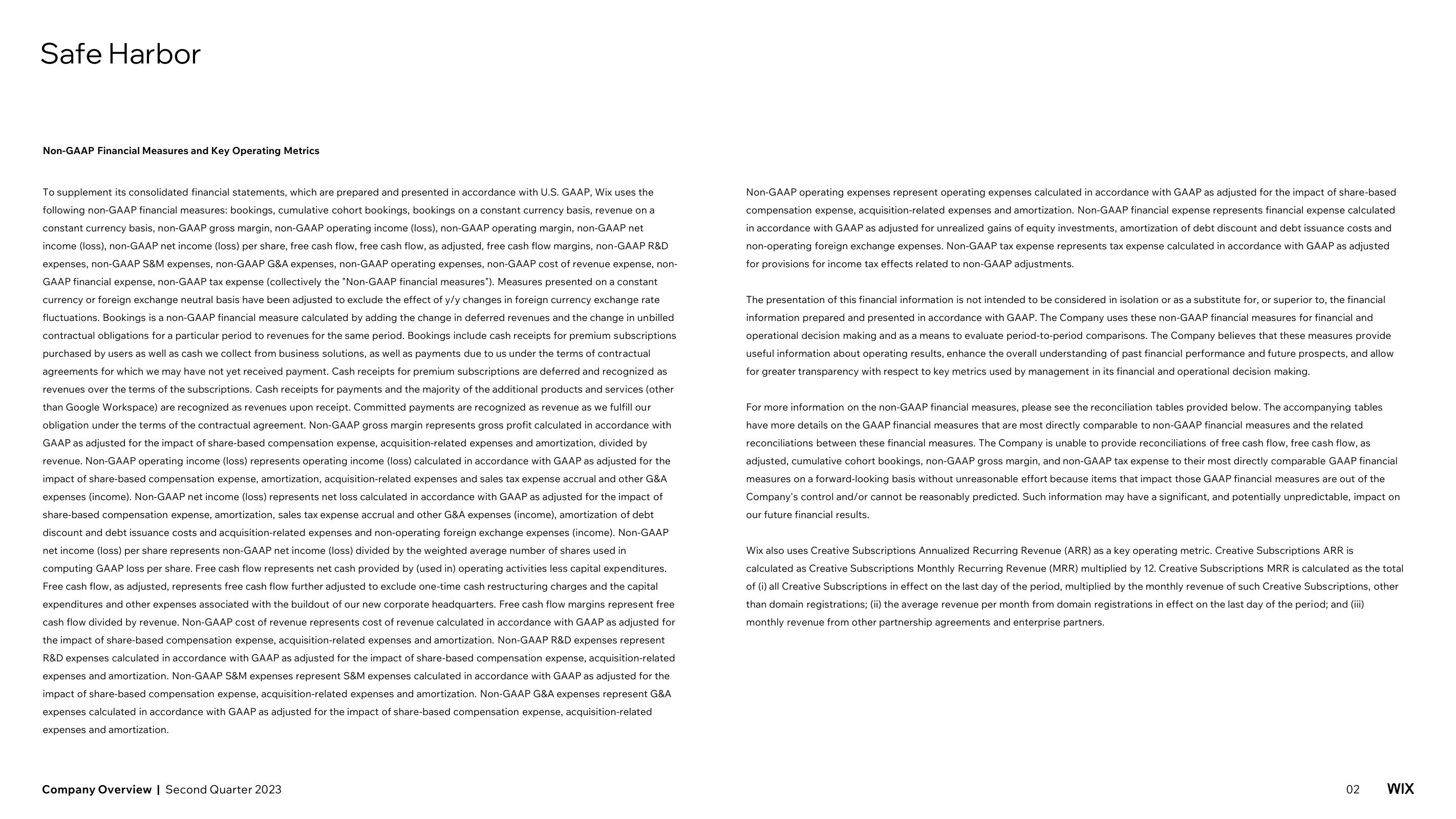Wix Investor Presentation Deck
Safe Harbor
Non-GAAP Financial Measures and Key Operating Metrics
To supplement its consolidated financial statements, which are prepared and presented in accordance with U.S. GAAP, Wix uses the
following non-GAAP financial measures: bookings, cumulative cohort bookings, bookings on a constant currency basis, revenue on a
constant currency basis, non-GAAP gross margin, non-GAAP operating income (loss), non-GAAP operating margin, non-GAAP net
income (loss), non-GAAP net income (loss) per share, free cash flow, free cash flow, as adjusted, free cash flow margins, non-GAAP R&D
expenses, non-GAAP S&M expenses, non-GAAP G&A expenses, non-GAAP operating expenses, non-GAAP cost of revenue expense, non-
GAAP financial expense, non-GAAP tax expense (collectively the "Non-GAAP financial measures"). Measures presented on a constant
currency or foreign exchange neutral basis have been adjusted to exclude the effect of y/y changes in foreign currency exchange rate
fluctuations. Bookings is a non-GAAP financial measure calculated by adding the change in deferred revenues and the change in unbilled
contractual obligations for a particular period to revenues for the same period. Bookings include cash receipts for premium subscriptions
purchased by users as well as cash we collect from business solutions, as well as payments due to us under the terms of contractual
agreements for which we may have not yet received payment. Cash receipts for premium subscriptions are deferred and recognized as
revenues over the terms of the subscriptions. Cash receipts for payments and the majority of the additional products and services (other
than Google Workspace) are recognized as revenues upon receipt. Committed payments are recognized as revenue as we fulfill our
obligation under the terms of the contractual agreement. Non-GAAP gross margin represents gross profit calculated in accordance with
GAAP as adjusted for the impact of share-based compensation expense, acquisition-related expenses and amortization, divided by
revenue. Non-GAAP operating income (loss) represents operating income (loss) calculated in accordance with GAAP as adjusted for the
impact of share-based compensation expense, amortization, acquisition-related expenses and sales tax expense accrual and other G&A
expenses (income). Non-GAAP net income (loss) represents net loss calculated in accordance with GAAP as adjusted for the impact of
share-based compensation expense, amortization, sales tax expense accrual and other G&A expenses (income), amortization of debt
discount and debt issuance costs and acquisition-related expenses and non-operating foreign exchange expenses (income). Non-GAAP
net income (loss) per share represents non-GAAP net income (loss) divided by the weighted average number of shares used in
computing GAAP loss per share. Free cash flow represents net cash provided by (used in) operating activities less capital expenditures.
Free cash flow, as adjusted, represents free cash flow further adjusted to exclude one-time cash restructuring charges and the capital
expenditures and other expenses associated with the buildout of our new corporate headquarters. Free cash flow margins represent free
cash flow divided by revenue. Non-GAAP cost of revenue represents cost of revenue calculated in accordance with GAAP as adjusted for
the impact of share-based compensation expense, acquisition-related expenses and amortization. Non-GAAP R&D expenses represent
R&D expenses calculated in accordance with GAAP as usted for the impact of share-based compensation expense, acq ition-related
expenses and amortization. Non-GAAP S&M expenses represent S&M expenses calculated in accordance with GAAP as adjusted for the
impact of share-based compensation expense, acquisition-related expenses and amortization. Non-GAAP G&A expenses represent G&A
expenses calculated in accordance with GAAP as adjusted for the impact of share-based compensation expense, acquisition-related
expenses and amortization.
Company Overview | Second Quarter 2023
Non-GAAP operating expenses represent operating expenses calculated in accordance with GAAP as adjusted for the impact of share-based
compensation expense, acquisition-related expenses and amortization. Non-GAAP financial expense represents financial expense calculated
in accordance with GAAP as adjusted for unrealized gains of equity investments, amortization of debt discount and debt issuance costs and
non-operating foreign exchange expenses. Non-GAAP tax expense represents tax expense calculated in accordance with GAAP as adjusted
for provisions for income tax effects related to non-GAAP adjustments.
The presentation of this financial information is not intended to be considered in isolation or as a substitute for, or superior to, the financial
information prepared and presented in accordance with GAAP. The Company uses these non-GAAP financial measures for financial and
operational decision making and as a means to evaluate period-to-period comparisons. The Company believes that these measures provide
useful information about operating results, enhance the overall understanding of past financial performance and future prospects, and allow
for greater transparency with respect to key metrics used by management in its financial and operational decision making.
For more information on the non-GAAP financial measures, please see the reconciliation tables provided below. The accompanying tables
have more details on the GAAP financial measures that are most directly comparable to non-GAAP financial measures and the related
reconciliations between these financial measures. The Company is unable to provide reconciliations of free cash flow, free cash flow, as
adjusted, cumulative cohort bookings, non-GAAP gross margin, and non-GAAP tax expense to their most directly comparable GAAP financial
measures on a forward-looking basis without unreasonable effort because items that impact those GAAP financial measures are out of the
Company's control and/or cannot be reasonably predicted. Such information may have a significant, and potentially unpredictable, impact on
our future financial results.
Wix also uses Creative Subscriptions Annualized Recurring Revenue (ARR) as a key operating metric. Creative Subscriptions ARR is
calculated as Creative Subscriptions Monthly Recurring Revenue (MRR) multiplied by 12. Creative Subscriptions MRR is calculated as the total
of (i) all Creative Subscriptions in effect on the last day of the period, multiplied by the monthly revenue of such Creative Subscriptions, other
than domain registrations; (ii) the average revenue per month from domain registrations in effect on the last day of the period; and (iii)
monthly revenue from other partnership agreements and enterprise partners.
02 WIXView entire presentation